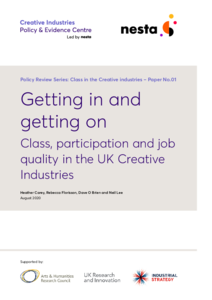
It was recently suggested that the pandemic poses ‘the biggest threat to the UK’s cultural infrastructure, institutions and workforce in a generation’ in an inquiry from the Department of Culture, Media and Sport (DCMS) Select Committee into the impact of COVID-19. Safeguarding the sustainability of the sector and restoring its position as one of the UK economy’s greatest success stories is a critical priority. But while current focus is offering much needed aid to the sector and unlocking its potential to support the wider recovery, it is important too to consider how we can rebuild the Creative Industries and creative occupations for the better – in a way that benefits more people and places across the UK.
Echoing wider research, we find widespread and persistent class imbalances. Those from privileged backgrounds are more than twice as likely to land a job in a creative occupation. They dominate key creative roles in the sector, shaping what goes on stage, page and screen. They are also more likely to experience greater autonomy and control over their work, to have supervisory responsibility and to progress into managerial positions.
We also find that class interacts with other factors – such as gender, ethnicity, disability and skill levels – to create ‘double disadvantage’. The intersection of class and skills has a particularly pronounced impact on the likelihood of landing a creative job, where those from a privileged background who are qualified to degree-level or above are 5.5 times as likely to secure a creative role than those of working-class background who are only skilled to GCSE-level.
Despite growing awareness of the issue and action by business, Government and industry stakeholders to promote greater inclusion, the likelihood of someone from a working-class background finding work in a creative occupation has remained largely unchanged since 2014.
This raises the important question of how we can evolve and enhance the current approach so as to: shift the dial on diversity in a significant and sustained way; build a genuinely open and inclusive creative economy that creates opportunities for all; that maximises talent; and enables all workers to thrive, irrespective of their socio-economic background.
Read the summary with five key facts about class in the creative industries, the full report, and the blog from Heather Carey, one of the report's authors.
Source: Executive Summary
